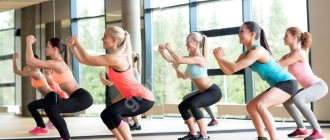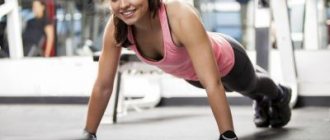In a calm, relaxed state, you don’t need to think about breathing; it is natural and effortless, like your heartbeat. During an intense load to develop a particular muscle, you have to monitor your inhalations and exhalations in order to mobilize and rationally use the body’s resources, perform the entire set of approaches and repetitions, give the muscles the necessary training, and overcome the next step towards the goal. The article is about the correct organization of the respiratory process during pull-ups on the horizontal bar.
How to do pull-ups correctly: basic rules
Learning how to do pull-ups on a horizontal bar is not that difficult. If you succeed, you will be able to effectively work out different muscle groups, in particular the muscles of the back and shoulder girdle. The latissimus, teres, and trapezius muscles work on the back. The chest is fully involved, as well as the biceps, triceps, deltoids, and forearms. Even the press is involved in the work, which acts as a stabilizer, fixing the static position of the torso.
Correct pull-ups on the horizontal bar require the following nuances :
- You must control your body completely. You need to pull yourself up using the strength of your muscles, without helping yourself by swinging or kicking.
- You need to lift your body smoothly , avoiding jerks and abrupt movements.
- During the exercise, you need to pull your chin. If a full pull-up is done rather than a partial pull-up, it should rise above the bar.
- After pulling up, there is no need to sharply lower your body down. You must do everything smoothly. The descent should take the same amount of time as the ascent.
- Proper breathing is very important when doing pull-ups on the horizontal bar, the basics of which we will look at below.
- Hold the bar firmly.
- The body should not hang crookedly. It should be straight, like a string. A slight arch in the back is allowed.
These are just general rules, and for each type of pull-up there are a number of recommendations. Next, let's look at what types of pull-ups there are.
Loop exercises
Don’t despair if nothing works out on the horizontal bar. There is an optimal solution that will allow you to prepare for complex exercises. This will require TRX loops. We buy and learn to pull ourselves up on them. If you don’t want to spend money, you can sign up for a gym. This sports equipment can be found in absolutely any gym. With its help, you can effectively work with any muscle groups even without any training.
The loops are designed to perform the following exercises:
- pull-ups;
- arm curls;
- push ups;
- pistol squats;
- lunges;
- rear delt raises.
You can also use the loops to perform various exercises to train your legs and abs. Thus, they are an excellent alternative to many exercise machines and allow for comprehensive training.
Pull-ups on the horizontal bar: types of grips
Almost all types of pull-ups require a standard hang as the starting position. The back is slightly arched, the legs are tucked and crossed. The following grip options are available:
- Straight narrow grip. Hands are slightly less than shoulder-width apart (narrow grip). When pulling up, try to touch the bar with your lower thoracic region. Let your gaze fall on your fingers.
- Straight medium grip. The hands are at a distance of shoulder width from each other. The shoulder blades should point towards each other when lifting. At the peak, you need to touch the bar with your upper chest. To increase the effectiveness of the exercise when descending, try to extend your arms completely.
- Reverse medium grip . Performed in the same way as the previous exercise, however, your shoulders should be pulled back and not raised when starting.
- Neutral grip. It is worth doing pull-ups with a neutral grip only when you have already mastered other techniques, since the grip will change during execution. For example, during the first approach, the left hand will be in front, then the right one. You need to touch the bar with your lower chest. You must firmly grasp the horizontal bar and place your fists one in front of the other. As you rise up, arch your back slightly.
- Wide grip chest pull-ups. With this type of exercise, the work occurs through the back muscles, not the biceps. You need to grab the bar from above with your thumbs, and spread your arms wide. When pulling up, the upper part of the chest should touch the bar, the elbows should be directed downward, and the eyes should look above the horizontal bar.
- Wide grip head pull-ups. This is a fairly effective, but at the same time very traumatic technique, so before you start doing the exercise, be sure to warm up and stretch your muscles. Grasp the bar with a wide grip and lower your elbows down. When pulling up, tilt your body forward slightly, trying to maintain a horizontal position. Thanks to this exercise, the round muscles of the back are perfectly worked out, which are almost not used in other types of exercises.
Of all the types of pull-ups, the exercise with a wide grip is considered the most difficult.
Therefore, first, it is recommended to master a straight medium grip, and only then other types of exercises. Wanting to learn how to properly do pull-ups, many athletes want to achieve multiple repetitions of the exercise. But you need to understand that gradualism is important with everything. The longer and more often you exercise, the more your body gets used to the stress. If you realize that you can no longer do more repetitions, reduce the frequency of training. You can’t exercise every day, because the muscles need time to recover, and during the resting process they also increase. The optimal training frequency is three times a week. It is recommended to do pull-ups in three sets with the maximum possible number of repetitions.
Tips for beginners learning pull-ups
Beginners who decide to improve their skills need to start by learning proper breathing.
It is important to remember simple rules that need to be constantly applied in practice:
- bending the elbows and lifting the body is done while exhaling;
- while inhaling, the body is lowered down;
- When performing training movements, you cannot retain air in your lungs, i.e. you need to breathe constantly.
Beginners entering the gym often have to hold their breath when performing pull-ups in order to concentrate, mobilize and overcome the load. This is not correct, because it leads to a decrease in results: a lack of oxygen does not allow you to do pull-ups for a long time, and reduces the number of times you lift and lower your body with your arms. A sign of improper breathing is dizziness that occurs after performing a set of exercises. If this happens, attention should be paid to how timely exhalations and inhalations are made when performing the training complex.
Beginners, whose physical fitness is far from the best, are especially likely to hold their breath or breathe incorrectly. For them, even a moderate load turns out to be prohibitively heavy, requiring complete mobilization of strength, which makes it impossible to monitor whether inhalations and exhalations are performed correctly.
People with such low training will have to work and improve their physical fitness first. If they want to learn how to do pull-ups, they will have to start with lightweight options. Exercises are suitable when the body is positioned at an angle to the crossbar and the feet are on the floor.
How to learn to do pull-ups on the horizontal bar: the correct technique
Before you learn how to do a pull-up correctly, you need to learn how to hang from a bar. For at least a week, do this for a few minutes. This is important so that your palms get used to the load and do not slip. When you are sure that your grip is strong and reliable, you can begin to perform the exercise itself.
Now about the pull-up technique. Firmly grasp the bar using a straight, medium grip. Gradually begin to pull your body towards the bar. The elbows should move slightly to the sides. To prevent your body from swaying, tense your abdominal muscles. At the maximum point, the chin should be higher than the horizontal bar. Now smoothly and gradually straighten your arms, slowly lowering your body.
Features of the correct technique
Many beginners are interested in the easiest way to do pull-ups on the horizontal bar. Professional trainers recommend starting with a classic grip. Grasp the bar so that your hands are at shoulder level or slightly wider. The back should be straight, the shoulder blades should be brought together, and the stomach should be slightly retracted. As you inhale, pull your body up, and as you exhale, lower it down.
Exercises should be done slowly so that all muscles are as tense as possible. If you have not played any sports before, it will be very difficult in the first stages. But don't rush. A little practice and you'll start to get it right. The main thing is to adhere to the correct technique. Only in this case will the training be effective.
However, try not to do the following:
- swing your body;
- arch your back;
- make too sudden movements;
- hold breath;
- pull your head into your shoulders.
If you can’t do pull-ups on the horizontal bar, then try different types of grip and choose the one that suits you best.
Common mistakes beginners make when doing pull-ups
You know how to do pull-ups on the horizontal bar for beginners, and you can start training. However, it is worth considering common mistakes that beginners often make in their first lessons.
- When doing pull-ups on the horizontal bar, you should only use your upper body . The legs should be calm, no effort is required from them. Beginners often sin with this, trying to climb onto the horizontal bar so that their chest finally rises above it. They swing their legs and give impulse to their joints, thus rising to the top, but this is fundamentally wrong. Pull-ups are only effective if they are done exclusively using the muscles of the arm and back. Moreover, the back works first, when you bring your shoulder blades together and thus provide the necessary tension, and then the arm muscles, through which the body is pulled upward.
- A very common mistake is sudden movements. Beginners often make careless sudden movements, especially when going down, or rather, as if falling down. This is not correct. In order for muscles to build correctly, the muscles must work as hard as possible, and with sudden movements you, on the contrary, free yourself from the load, and also increase the risk of injury. All movements must be smooth and accurate. You need to rise and fall in the same rhythm.
- Another shortcoming that is often found among those who are just mastering the horizontal bar is straightening the elbows completely , which most often occurs when lowering the body. Please note that the load on the elbow joints during the exercise is very strong, so you cannot straighten them completely either when ascending or descending - otherwise there is a considerable risk of injuring the elbow joints.
- Don't aim for an intense pace. Fast does not mean good, especially if you have just started training. You can do pull-ups many times in a minute, but the muscles will receive minimal load; accordingly, efficiency is significantly reduced, but the unwanted load on the joints increases. When pulling yourself up, don't rush . Do the exercise slowly, smoothly, consistently, feeling how the muscles of your back, arms, and shoulders tense.
- Improper breathing is also a common mistake. Beginners, who find it difficult to do pull-ups due to lack of experience, often involuntarily hold their breath, breathe quickly, lose the correct rhythm, but this should not be done. Breathe smoothly and measuredly, rising as you exhale and descending as you inhale.
- Another point is neck tension. In any case, the neck muscles will strain when pulling up, however, the main load should not be placed on them. First of all, the back, arms and abs work, and there is no need to transfer their load to the neck. Control your movements so as not to overstrain your neck muscles and cause injury.
- Don't rush into weights. Many athletes who have already mastered standard pull-ups increase the load using special weight vests, belts, and plates. But this can only be done if you are fluent in the technique of doing pull-ups with your own weight.
Optimal training scheme
Above we described in detail how to learn pull-ups. But to achieve the desired result, following the correct technique is not enough. It is equally important that classes are regular. Therefore, it is better to develop your own training program, which will include exercises aimed at working the muscles of all groups of the upper body. Ideally, you will study every day, but if this is not possible due to being very busy, then you need to set aside at least three days.
It is better to start training with pull-ups on the horizontal bar with a wide grip. But if it turns out to be too difficult for you, then you can use any other type. For beginners, the following weekly training schedule will be optimal:
- first - 3 sets of 6 times;
- second - 3 sets of 10 times;
- third - 4 sets of 10 times;
- fourth - 4 sets of 15 times;
- fifth - 4 sets of 20 times;
- sixth - 5 sets of 25 times.
Now you know how long you need to do pull-ups on the horizontal bar. During your workout, give your muscles a few minutes of rest. If this scheme turns out to be too difficult for you, then you can make certain adjustments to it, adapting the program to your physical abilities.
Basics of proper breathing when doing pull-ups
It is very important to know how to breathe correctly when doing pull-ups on the horizontal bar. Thanks to the correct breathing technique, you will be able to get less tired during physical activity, in addition, your muscles, like the body as a whole, will receive a sufficient amount of oxygen. Breathing should be even and deep, you should not hold it.
For any type of physical activity, the general rule applies: the main effort is performed on exhalation, relaxation - on inhalation.
To understand how to breathe correctly when doing pull-ups, follow a certain algorithm that will help you adjust your breathing in the right way and make it easier to perform the exercise:
- Hang on the horizontal bar, bend your legs slightly at the knees and take them back.
- Squeeze your shoulder blades to the maximum point of tension while inhaling deeply through your nose.
- Slowly lift your body up while exhaling smoothly. It should continue until you reach the top peak point.
- Without fixing the body at the top point, begin to slowly descend, accompanying the descent with a smooth exhalation through the nose.
- Repeat the exercise again in the same sequence.
Anyone can learn to do pull-ups. To do this, you only need regular training and knowledge of some basic rules. We invite you to watch a video on how to properly do pull-ups on a horizontal bar, which will also help you master this exercise.
Jumping pull-ups
When a person just starts playing sports, he is faced with one very big problem, namely, insufficient physical development. Many beginners who have no idea how to learn how to do pull-ups on a horizontal bar immediately try to master complex techniques. As a result, they fail and decide to quit exercising. Experienced trainers recommend starting with simple exercises and gradually increasing the load.
One of these is jumping pull-ups. Its essence is to push off the ground with your feet, giving your body acceleration, after which your arms take the load. Before returning to the starting position, you need to hover in the air for a few seconds. All movements should be leisurely and smooth.
Tips for beginners for effective training
Correct breathing technique when doing pull-ups on the horizontal bar will reduce physical fatigue, increase training productivity, and achieve your goals faster.
Anyone can learn to breathe correctly. The main thing is to listen to the advice of professional athletes:
- You cannot perform a full cycle of pull-ups on one inhalation or exhalation (that is, make a downward movement). Lifting must be done while exhaling, lowering the body - while inhaling;
- It is forbidden to hold your breath at the peak point of tension, as this will lead to an increase in blood pressure, and, as a result, dizziness, fainting and even cerebral hemorrhage. You need to breathe evenly, deeply, resting, if you don’t have the strength to continue doing pull-ups;
- It is not recommended to change the rhythm and pace of breathing during the exercise. It is advisable to perform it at the same pace and rhythm as they were at the very beginning (this especially applies to beginners);
- after 10-15 repetitions, as a rule, the speed of the exercises decreases, and it becomes impossible to maintain the previously set respiratory rate. In such cases, professionals advise that when hanging on straight arms, take an additional two or more breaths and delay the execution for a few seconds.
Did you know? The world record for the number of pull-ups on the bar in 60 minutes belongs to Russian athlete Nikolai Kaklimov from the Krasnoyarsk Territory. He managed to do 844 pull-ups.
Safety precautions: how to breathe properly
There are no dangerous or safe exercises. There is a right and wrong technique. If the technique is incorrect, any exercise becomes dangerous. And pull-ups are no exception.
Beginners, as a rule, make a typical mistake - they jerk their head back, lifting their chin up while performing the exercise. Most people do a pull-up while inhaling. Instinctively. At the same time, they bring their shoulders together. You should never do this - you can get severe injury to the cervical vertebrae and protrusion of herniated intervertebral discs.
The correct technique for performing the exercise involves absolutely opposite actions: before performing a pull-up, the chest should be filled with air as much as possible and your breath should be held. And then the task of the latissimus dorsi muscles will be easier when they “push” your body up. And you will insure yourself against stretching of the small muscles that serve the shoulder blade. Otherwise, every slight movement of the body will cause severe pain in the upper back.
Since you're doing pull-ups primarily to broaden your back, you shouldn't squirm your entire body during the exercise , trying to complete the rep at any cost. You need to pull yourself up strictly vertically, by lowering your elbows. If your amplitude is short, then perform pull-ups in a machine with a counterweight.
Learn to do pull-ups from scratch. The most effective techniques will allow you to do your first repetitions on the horizontal bar in the shortest possible time.
Tips on how to give an injection in the buttock are here. May be useful for everyone.
Types of grips
The distribution of the load depends on how you hold the bar while stretching. Grips are classified according to two criteria:
- distance between hands;
- way to grab the crossbar.
Depending on the distance between the hands, the grip exists:
- medium grip (A and B);
- narrow grip (E and F);
- wide grip (C).
Depending on the method of gripping the crossbar, the grip exists:
- straight grip (A, C, E);
- reverse grip (B, F).
- neutral grip (D);
A straight grip is called when the palms “look” away from the face. It is also called pronated and overhand grip.
When the grip is performed from below, and the palms “look” at the athlete’s face, then this is a supinated or reverse grip.
With such grips, the person’s body is parallel to the crossbar.
To perform a neutral grip pull-up, position yourself so that your torso is perpendicular to the bar. Hands in.
Now with grip width:
- if the distance between the athlete’s hands is less than the width of his shoulders, then this is a narrow grip;
- when the hands are shoulder-width apart, or slightly wider, then this is a medium grip;
- when the distance between the palms is significantly greater than the width of the shoulders, then this is a wide grip.
Hoop is not just children's fun. About how to lose weight with a hoop here.
Correct technique
In order for pull-ups to bring maximum benefit to your body, you must follow the rules for performing the exercise. Namely:
- pull-ups should be performed without body swaying or inertia, only using muscle strength;
- lifting the body should be done smoothly, without jerking;
- at the top point of the exercise, the chin should be above the bar;
- the lowering of the body also occurs smoothly - the duration of the descent is equal to the duration of the ascent of the body;
- you should breathe correctly when doing pull-ups: exhale when going up, and inhale when going down;
- the grip must be strong;
- the housing must be positioned strictly vertically.
Naturally, these are the most general rules, and each type of pull-up has its own nuances.
The starting position for all types of pull-ups, except for pull-ups behind the head with a wide grip, is a free hang, the back is slightly arched. Legs are slightly bent at the knees and crossed.
When pulling up, you should strive to touch the horizontal bar with your lower chest. In this case, the gaze should be directed to the hands.
Performed in exactly the same way as straight-grip pull-ups. But there is a difference - when lifting, you should make sure that your shoulders are pulled back and your shoulder blades are brought together.
The technique of this exercise is to lift the body and simultaneously bring the shoulder blades together. At the peak of the lift, you should touch the horizontal bar with the top of your chest. In order for the back muscles to stretch well, you should straighten your arms completely while descending.
When performing this exercise, you should try to lift only using the latissimus dorsi muscles, “turning off” the biceps. The thumbs do not grip the bar from below, but are placed on top of it. When lifting, you should ensure that the upper chest and the horizontal bar come into contact. Elbows point to the floor, gaze directed upward.
When performing this type of pull-up, unlike all the previous ones, you do not need to bend your back, and you should not cross your legs either. The legs, on the contrary, should be straightened with the body in one line, the back straight. You need to “come” to the top point so that the crossbar is behind your head. At the top point, your elbows should be directed towards the floor. Be sure to monitor your head position to avoid injury.
How to learn to do pull-ups
Every man asks himself this question at one time or another. The most important thing when mastering pull-ups is not to rush anywhere. Because it is very important for the development of muscle mass that the exercise is performed slowly .
The slower you move up and down, the better. Start with a simple hang on the bar. Every day increasing the hanging time. Your hands should get used to the load. Otherwise they will slip off. When you feel that your grip has become strong, you can start doing pull-ups. Mastering this exercise begins with pull-ups with a medium grip. Hands shoulder width apart. Firmly grasp the bar and smoothly pull your body up. Your elbows should be slightly out to the sides and moving downwards. To stabilize your core, you should tighten your abdominal muscles. Once your chin is higher than the bar, slowly lower yourself down until your arms are completely straight.
As you can see, there is nothing complicated about pull-ups. just shouldn’t rush, but try to do the exercise with the correct technique . If you master it, then everything will go easier. Gradually you should increase the number of pull-ups and master new grips.
Finally, we recommend watching a video that discusses in detail all aspects of the correct execution of pull-ups on the bar.
Pull-ups on the bar Technique and useful tips
Pull-ups on the horizontal bar are one of the most effective exercises performed with your own weight. And all you need for training is a crossbar and the desire to make your body more perfect.
Pull-ups are very often part of various complexes designed to develop muscle groups of the arms, shoulders, chest and back. In this regard, pull-ups are a unique exercise, comparable in effectiveness only to the basic exercises in bodybuilding - squats, bench press and deadlift.
What muscles work when doing pull-ups on the bar:
- back: trapezoid, lats, round, diamond-shaped;
- breasts: small and large;
- shoulders: brachialis, triceps, biceps, rear delta;
- front serrated.
To keep the body constantly in an upright position, the press does a lot of work.
But pull-ups will become a highly effective exercise only when the technique for performing them is correct.











